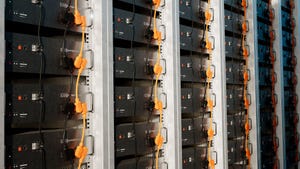Google Files Patent on UPS ArchitectureGoogle Files Patent on UPS Architecture
A group of engineers from Google (GOOG) have applied for a patent on a highly efficient power supply for servers that integrates a battery, allowing it to function as an uninterruptible power supply (UPS).
February 15, 2008
A group of engineers from Google have applied for a patent on a highly efficient server-level power supply that integrates a battery, allowing it to function as an uninterruptible power supply (UPS). The design effectively shifts the UPS and battery backup functions from the data center into the server cabinet.
The patent application was filed Feb. 7 under the name Exaflop LLC rather than Google Inc, reflecting the company's interest in secrecy about its data center operations. The listed address for Exaflop is 1600 Amphitheatre Parkway in Mountain View, Calif., which is Google's headquarters. The inventors listed on the patent include Google engineer William Whitted and Gerald Aigner, who were also cited in Google's patent on a portable data center in a shipping container. Also listed on the UPS patent application are Google data center R&D manager Jimmy Clidaras and Google employees Benchiao Jai and William Hamburgen, among others.
Google (GOOG) has been building its own highly-efficient power supplies for its servers since at least 2006, and has called upon the computer industry to standardize power supplies as a way to capture huge energy savings. It also builds its own servers, which run on customized OS and web server software. Recently there have been reports that it is building its own energy efficient 10 Gigabit Ethernet switches. But the filing is the first sign that Google engineers are also innovating in UPS equipment.
The UPS design in the patent submission is described as "highly efficient" because it features a single AC-to-DC conversion, with AC grid power going to the rack. The server-level UPS includes a fault detection system and a battery, and will switch to battery backup if it detects an interruption in grid power. The system also includes a controller that monitors battery life and can shut down the equipment gracefully if the battery runs low.
Many data centers use AC power distribution in which a UPS system stands between the utility power grid and the data center equipment. When there is a grid outage, the UPS system taps a large bank of batteries (or in some cases, a flywheel) for "ride-through" power until the generator can be started. The AC power from the grid is converted into DC power to charge the batteries, and then converted back to AC for the equipment. The loss of power through multiple AC/DC conversions has been cited as an argument for using DC power distribution.
In the primary configuration discussed in the Exaflop patent application, that ride-through function for the server is assigned to a small battery housed in each server tray or blade within the rack. The UPS has the ability to auto-detect battery chemistry to enable the use of different types of batteries, and uses non-volatile memory (NVM) to store set point information.
The filing notes that the architecture is flexible enough to allow many configurations, including the use of a flywheel. A diagram shows the primary grid power entering the data center through AC switchgear, which in the event of an outage can tap either a diesel generator or a "colocated generator" that could be a flywheel or a turbine driven by wind power or solar energy.
The use of renewable energy in datacenters is a priority for Google, which is using a windmill farm to provide supplementary power to a data center in the Netherlands. The Google Foundation is also investing in "utility scale" solar power technology that uses reflected sunlight as a heat-source to drive electric generators.
Power supplies have been the focus of Google senior vice president of network operations Urs Holzle, who in 2006 co-authored a white paper discussing Google's use of custom power supplies with an efficiency of 90 percent or better. Holzle and colleague Bill Weihl said Google standardized on a 12V power supply, and the use of voltage regulator modules (VRM) to manage the need for alternate voltages on the motherboard.
NOTE: Patent applications are notoriously dense and technical, and the Exaflop LLC submission is no different. We've sought to summarize the filing as best we can, but invite readers to review the filing for themselves. Readers with expertise in patent filings and/or UPS architecture are invited to offer their observations and feedback in the comments.
Read more about:
Google AlphabetAbout the Author
You May Also Like







